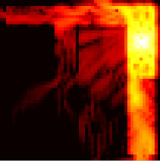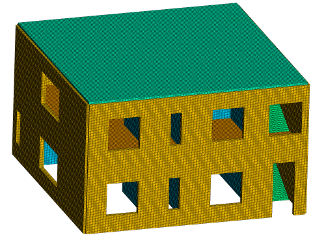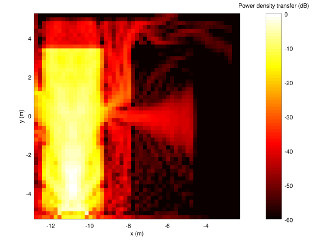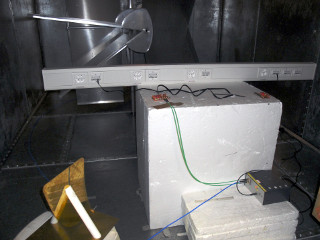Strategies for the Improvement of Critical Infrastructure Resilience to Electromagnetic Attacks (STRUCTURES)

Funder: ERC
Date: July 2012 - June 2015
Web pages: CORDIS
My roles: Task leader, researcher
Modern civilian society is dependent on a number of systems that must function together in order to enable society itself to function. The term “critical infrastructure” (CI) has become common terminology to refer to these systems, which include, for example, energy generation and distribution, communication and transport systems. STRUCTURES, Strategies for The impRovement of critical infrastrUCTUre Resilience to Electromagnetic attackS, was an ERC funded project that analysed the possible impacts of intentional electromagnetic interference (IEMI) attacks targeted at such CIs on our defence and economic security. It identified innovative awareness and protection strategies for CIs, which through the European Commission have provided policy makers with an understanding of the possible consequences of an electromagnetic attack and the mitigation measures that can be applied.



The project was led by IDS with twelve other partners: UOY, EPFL, HESSO, UCBM, UT, Montena, HSU, BUW, LUH, ISMB, RWM and NAVI. Overviews of the aims and results of the project can be found in the conference papers (van de Beek et al., 2014; van de Beek et al., 2015).
 Simulation of a fast IEMI pulse hitting an office building (click image to play)
Simulation of a fast IEMI pulse hitting an office building (click image to play)
The video above shows the time evolution of the electric field inside a small office building that is irradiated by a plane electromagnewtic wave, which is an approximate model for the illuminating wave that would be generated by a strong IEMI source located far from the building. The video depicts the vertical electric field component 1.5 m above floor level in a plane throught the lower floor of the building shown in the left of the image gallery above. The effect of the walls and and windows on the field distribution can be seen particularly clearly in the “heat plot” below the surface plot.
The project considered the susceptbilities of different comonents of CIs, including cabling networks and equipment (Mora et al., 2016; Camp et al., 2015). Another important aspect of managing the risk of IEMI is being able to detect and localise an attack. The project considered different strategies and types of detection and locaisation system, details of which are reported in (Dawson et al., 2016; Dawson et al., 2015; Stojilović et al., 2014; Dawson et al., 2014; Dawson et al., 2014)
References
- Mora, N., Flintoft, I.D., Dawson, L., Dawson, J.F., Rachidi, F., Rubinstein, M., Marvin, A.C., Bertholet, P. and Nyffeler, M., 2016. Experimental characterization of the response of an electrical and communication raceway to IEMI. IEEE Transactions on Electromagnetic Compatibility, 58(2), pp.494–505.
This paper reports the results of two experimental campaigns aimed at studying the high-frequency response of a raceway containing low voltage power, telephone, and Ethernet cables, to external electromagnetic field illumination. The raceway was tested against HPEM transients inside a gigahertz transverse electromagnetic (GTEM) cell and low-power fields inside a reverberation chamber (RC). The high-power electromagnetic (HPEM) tests revealed that the low-voltage power cables have the greatest coupling under a hyperband illumination, compared to telephone and Ethernet cables. The RC tests allowed the determination of statistical transfer functions from random incident field configurations into DM voltage in cable loads. The responses were found to be governed by the raceway under test at the lower frequencies (below 1 GHz). Between 0.2 and 1 GHz, the raceway gives about 10 dB higher coupling than a short patch cable. The difference is even greater at lower frequencies and for shielded cables. In the frequency band 1-3 GHz, little difference was observed between short patch cables and the full raceway, but both were still significantly higher than direct coupling to the measurement card. Beyond 3 GHz, the coupling is clearly dominated by the terminal equipment. The experiments performed in this paper provide a better understanding of the expected induced voltages and currents in commercial cable systems when exposed to intentional electromagnetic interference (IEMI)-like signals.
@article{Mora2016, author = {Mora, N. and Flintoft, I. D. and Dawson, L. and Dawson, J. F. and Rachidi, F. and Rubinstein, M. and Marvin, A. C. and Bertholet, P. and Nyffeler, M.}, title = {Experimental characterization of the response of an electrical and communication raceway to IEMI}, journal = {IEEE Transactions on Electromagnetic Compatibility}, year = {2016}, volume = {58}, number = {2}, pages = {494-505}, month = apr, issn = {0018-9375}, note = {Date of acceptance: 12/12/2015. © 2016 IEEE. Personal use of this material is permitted. Permission from IEEE must be obtained for all other uses, in any current or future media, including reprinting/republishing this material for advertising or promotional purposes, creating new collective works, for resale or redistribution to servers or lists, or reuse of any copyrighted component of this work in other works.}, doi = {10.1109/TEMC.2015.2510423}, file = {:pdfs/TEMC58-Mora-494.pdf:PDF}, keywords = {Intentional electromagnetic interference, immunity testing, EMP radiation effects, reverberation chambers, electromagnetic coupling, cable shielding}, postprint = {https://pure.york.ac.uk/portal/files/46384003/TEMC2510423_postprint.pdf}, publisher = {IEEE} } - Dawson, J.F., Flintoft, I.D., Marvin, A.C., Robinson, M.P. and Dawson, L., 2016. Power-balance in the time-domain for IEMI coupling prediction. In: Proceedings of the 14th Ultra-Wideband, Short-Pulse Electromagnetics Conference at the European Electromagnetics Smposium (EuroEM 2016). London, UK.
In this paper we describe the use of the power-balance technique to estimate coupling into enclosures in the time domain for the prediction of coupling of Intentional Electromagnetic Interference (IEMI). The time domain method allows the peak fields for pulsed waveforms to be estimated.
@inproceedings{Dawson2016a, booktitle = {Proceedings of the 14th Ultra-Wideband, Short-Pulse Electromagnetics Conference at the European Electromagnetics Smposium (EuroEM 2016)}, month = {11-15 July}, address = {London, UK}, author = {Dawson, J. F. and Flintoft, I. D. and Marvin, A. C. and Robinson, M. P. and Dawson, L.}, title = {Power-balance in the time-domain for {IEMI} coupling prediction}, year = {2016}, note = {IET and Summa Foundation have permission to publish, but rights retained by authors.}, file = {:pdfs/EUROEM2016-Dawson-1.pdf:PDF}, keywords = {power balance, IEMI, time-domain, shielding}, postprint = {https://pure.york.ac.uk/portal/files/48025898/TD_PWB_V4_postprint.pdf} } - Beek, S. van de, Dawson, J., Dawson, L., Flintoft, I., Garbe, H., Leferink, F., Menssen, B., Mora, N., Rachidi, F., Righero, M., Rubinstein, M. and Stojilović, M., 2015. The European project STRUCTURES: Challenges and results. In: 2015 Joint IEEE International Symposium on Electromagnetic Compatibility and EMC Europe. Dresden, Germany: IEEE, pp.1095–1100.
The project STRUCTURES, funded by the European Union, started in July 2012 to study problems related to the emerging threats of electromagnetic attacks to critical infrastructures. Partners of the team have worked to list possible threats, identify the main characteristics of the critical infrastructures our way of living depends on, test current protection strategies with different simulation and measurement techniques, and condensate the results in guidelines accessible to an audience wider than the one of people working in the field. Here, we summarize the challenges, the solutions, and the results of almost three years of work.
@inproceedings{vandeBeek2015, issn = {2158-110X}, booktitle = {2015 Joint IEEE International Symposium on Electromagnetic Compatibility and EMC Europe}, month = {16-22 August}, address = {Dresden, Germany}, author = {van de Beek, S. and Dawson, J. and Dawson, L. and Flintoft, I. and Garbe, H. and Leferink, F. and Menssen, B. and Mora, N. and Rachidi, F. and Righero, M. and Rubinstein, M. and Stojilović, M.}, title = {The European project STRUCTURES: Challenges and results}, year = {2015}, pages = {1095--1100}, publisher = {IEEE}, doi = {10.1109/ISEMC.2015.7256321}, file = {:pdfs/EMCE2015-vandeBeek-1095.pdf:PDF}, isbn = {978-1-4799-6615-8}, keywords = {electromagnetic interference, electromagnetic shielding, electromagnetic attack threats}, owner = {idf1}, postprint = {https://pure.york.ac.uk/portal/files/50259399/EMCE2015_vandeBeek_1095_postprint.pdf}, timestamp = {2016.10.12} } - Dawson, J.F., Dawson, L., Flintoft, I.D. and Rebers, L., 2015. IEMI detection systems: A low cost IEMI detector. In: 2015 Joint IEEE International Symposium on Electromagnetic Compatibility and EMC Europe, WS26: IEMI effects on critical infrastructures: The European project STRUCTURES. Dresden, Germany.
@conference{Dawson2015, author = {Dawson, J. F. and Dawson, L. and Flintoft, I. D. and Rebers, L.}, title = {IEMI detection systems: A low cost IEMI detector}, booktitle = {2015 Joint IEEE International Symposium on Electromagnetic Compatibility and EMC Europe, WS26: IEMI effects on critical infrastructures: The European project STRUCTURES}, year = {2015}, address = {Dresden, Germany}, month = {16-22 August}, note = {In Workshop 26 (WS26): IEMI effects on critical infrastructures: The European project STRUCTURES}, file = {:pdfs/EMCE2015-Dawson-WS26.pdf:PDF}, owner = {idf1}, postprint = {https://pure.york.ac.uk/portal/files/40237388/UoY_Montena_Dresden_WS26_6a_IEMI_Detection_1up_col.pdf}, timestamp = {2016.10.12} } - Camp, M., Mora, N., I. D. Flintoft, S.van de B., Rachidi, F. and Leferink, F., 2015. Experimental characterization of critical systems and components. In: 2015 Joint IEEE International Symposium on Electromagnetic Compatibility and EMC Europe, WS26: IEMI effects on critical infrastructures: The European project STRUCTURES. Dresden, Germany.
An extensive experimental campaign was conducted during the project aimed to fine tune the simulation models or to validate the accuracy of the adopted approximations in the calculation of the simplified transfer functions. Characteristic components and systems of CIs, like TETRA base stations or cable raceways, are investigated according to transfer functions and susceptibility thresholds. These results are the basis for simulation and the concluding assessment of the CIs resilience against IEMI attacks.
@conference{Camp2015, author = {Camp, M. and Mora, N. and I. D. Flintoft, S. van de Beek and Rachidi, F. and Leferink, F.}, title = {Experimental characterization of critical systems and components}, booktitle = {2015 Joint IEEE International Symposium on Electromagnetic Compatibility and EMC Europe, WS26: IEMI effects on critical infrastructures: The European project STRUCTURES}, year = {2015}, address = {Dresden, Germany}, month = {16-22 August}, note = {In Workshop 26 (WS26): IEMI effects on critical infrastructures: The European project STRUCTURES}, file = {:pdfs/EMCE2015-Camp-WS26.pdf:PDF}, owner = {idf1}, timestamp = {2016.10.12} } - Stojilović, M., Menssen, B., Flintoft, I.D., Garbe, H., Dawson, J.F. and Rubinstein, M., 2014. TDoA-based localisation of radiated IEMI sources. In: 2014 International Symposium on Electromagnetic Compatibility (EMC EUROPE 2014). Gothenburg, Sweden: IEEE, pp.1263–1268.
@inproceedings{Stojilovic2014, issn = {2325-0356}, booktitle = {2014 International Symposium on Electromagnetic Compatibility (EMC EUROPE 2014)}, month = {1-4 September}, publisher = {IEEE}, address = {Gothenburg, Sweden}, author = {Stojilović, M. and Menssen, B. and Flintoft, I. D. and Garbe, H. and Dawson, J. F. and Rubinstein, M.}, title = {TDoA-based localisation of radiated IEMI sources}, year = {2014}, pages = {1263--1268}, doi = {10.1109/EMCEurope.2014.6931098}, file = {:pdfs/EMCE2014-Stojilovic-1263.pdf:PDF}, isbn = {978-1-4799-3225-2}, keywords = {electromagnetic interference, time-of-arrival estimation, intentional electromagnetic interference, critical infrastructure}, owner = {idf1}, timestamp = {2016.10.12} } - Dawson, J.F., Flintoft, I.D., Kortoci, P., Dawson, L., Marvin, A.C., Robinson, M.P., Stojilovic, M., Rubinstein, M., Menssen, B., Garbe, H., Hirschi, W. and Rouiller, L., 2014. A cost-efficient system for detecting an intentional electromagnetic enterference (IEMI) attack. In: 2014 International Symposium on Electromagnetic Compatibility (EMC EUROPE 2014). Gothenburg, Sweden: IEEE, pp.1252–1256.
This paper describes a cost-efficient Intentional EMI Detection system and gives a brief overview of the identification and location system being developed as part of the STRUCTURES project.
@inproceedings{Dawson2014, issn = {2325-0356}, booktitle = {2014 International Symposium on Electromagnetic Compatibility (EMC EUROPE 2014)}, month = {1-4 September}, publisher = {IEEE}, address = {Gothenburg, Sweden}, author = {Dawson, J. F. and Flintoft, I. D. and Kortoci, P. and Dawson, L. and Marvin, A. C. and Robinson, M. P. and Stojilovic, M. and Rubinstein, M. and Menssen, B. and Garbe, H. and Hirschi, W. and Rouiller, L.}, title = {A cost-efficient system for detecting an intentional electromagnetic enterference (IEMI) attack}, year = {2014}, pages = {1252-1256}, note = {© 2014 IEEE. Personal use of this material is permitted. Permission from IEEE must be obtained for all other uses, in any current or future media, including reprinting/republishing this material for advertising or promotional purposes, creating new collective works, for resale or redistribution to servers or lists, or reuse of any copyrighted component of this work in other works.}, doi = {10.1109/EMCEurope.2014.6931096}, file = {:pdfs/EMCE2014-Dawson-1252.pdf:PDF}, keywords = {signal detection, telecommunication security, intentional electromagnetic interference, location system}, owner = {idf1}, postprint = {https://pure.york.ac.uk/portal/files/33710546/STRUCTURES_IEMI_Sensor_EMC_Europe_2014_v11_postprint.pdf}, timestamp = {2016.10.12} } - van de Beek, S., Dawson, J., Flintoft, I.D., Leferink, F., Mora, N., Rachidi, F. and Righero, M., 2014. Overview of the European project STRUCTURES. Electromagnetic Compatibility Magazine, IEEE, 3(4), pp.70–79.
An overview of the European project STRUCTURES and its main challenges is given. Current and foreseen Intentional Electromagnetic Interference (IEMI) threats are classified according to their availability, their technical characteristics (such as bandwidth) and their portability. Critical infrastructures are identified and their most characteristic aspects are highlighted, from an electromagnetic point of view. These concepts are used to establish a set of reference threats to be investigated and possible techniques to handle simulations and measurements in this complex environment are explored, emphasizing the use of the topological approach.
@article{vandeBeek2014, author = {{van de Beek}, Stefan and Dawson, John and Flintoft, {Ian David} and Leferink, Frank and Mora, Nicolas and Rachidi, Farhad and Righero, Marco}, title = {Overview of the European project STRUCTURES}, journal = {Electromagnetic Compatibility Magazine, IEEE}, year = {2014}, volume = {3}, number = {4}, pages = {70--79}, issn = {2162-2264}, doi = {10.1109/MEMC.2014.7023202}, file = {:pdfs/EMCM3-vandeBeek-70.pdf:PDF}, keywords = {critical infrastructures, electromagnetic interference, intentional electromagnetic Interference, topological approach}, owner = {idf1}, postprint = {https://pure.york.ac.uk/portal/files/50259507/EMCM3_vandeBeek_70_postprint.pdf}, timestamp = {2016.10.12} } - Dawson, J.F., Flintoft, I.D., Rebers, L., Camp, M., Schmitz, J. and Jung, M., 2014. Circuit and electromagnetic modelling of a low cost IEMI Sensor. In: EMCUK 2014. Newbury, UK.
@conference{Dawson2014b, author = {Dawson, J. F. and Flintoft, I. D. and Rebers, L. and Camp, M. and Schmitz, J. and Jung, M.}, title = {Circuit and electromagnetic modelling of a low cost IEMI Sensor}, booktitle = {EMCUK 2014}, year = {2014}, address = {Newbury, UK}, month = {7-8 October}, file = {:pdfs/EMCUK2015-Dawson-1.pdf:PDF}, owner = {idf1}, postprint = {https://pure.york.ac.uk/portal/files/32833767/UoY_Sensor_model_v4.pdf}, timestamp = {2016.10.12} }